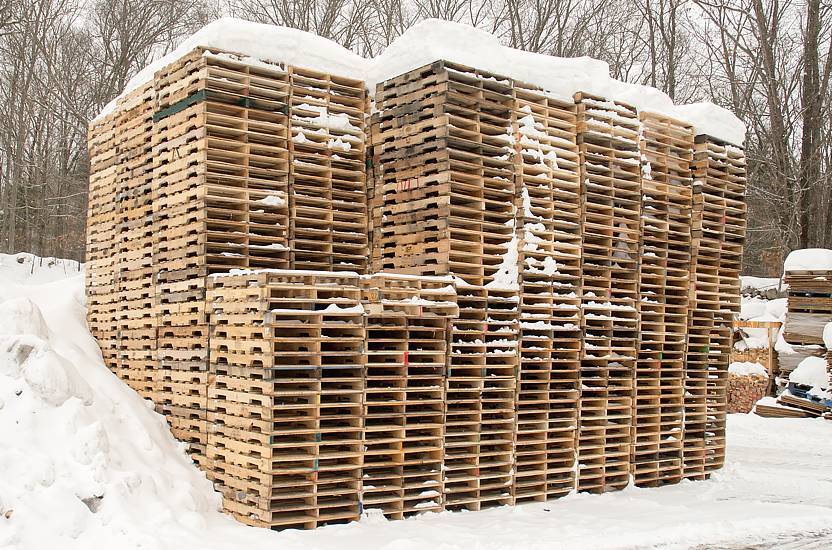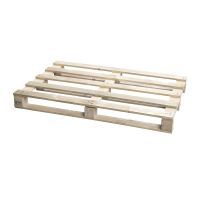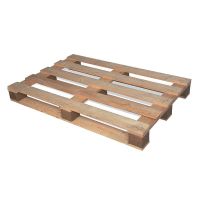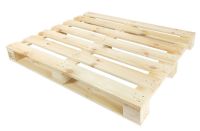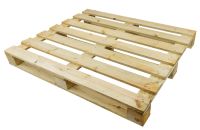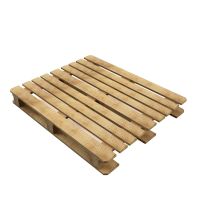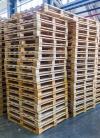Have you ever wondered how the harsh winter weather conditions can affect your wooden pallets if they are exposed to snow or frost for several weeks or months? It turns out that even a small amount of water can cause major damage to wooden pallets. How can you avoid this?
To keep wooden pallets in good condition for long-term use, you need to take care not only of proper handling but also storage in appropriate conditions. Harsh winter weather conditions, such as snow, ice and rain, can have a detrimental effect on wooden pallets, especially when they are exposed to it for a long time.
New wooden pallets are manufactured from high-quality pine or spruce wood, but this can lose its properties over time if the pallets are not protected from precipitation and ventilation is not provided in the storage area. According to PN-89/M-78201, which specifies storage conditions for wood cargo pallets, section 4.3 states "Pallets should be stacked on spacers and stored in rooms protected from precipitation." Proper storage conditions will protect pallets from damage. But first, let's see what happens to wooden packages when they are not protected.
How do snow and ice affect wooden pallets?
Pallets made from timber as a natural raw material retain water like a sponge. This means that if pallets are exposed to wet snow for several weeks or months, this can lead to mould growth on the pallets, weakening their structural integrity.
On the other hand, low temperatures alone do not harm pallets provided the pallets are stored in a ventilated area or are allowed to dry outside in better weather.
Humidity and rain have an even greater effect on the loss of quality of wooden pallets than ice and snow. Rainfall causes wooden pallets to quickly become damp and promotes mould growth, especially if the damp carriers are too close together or wrapped in plastic. Although the extent of damage can vary from one type of wood to another, the longer pallets are exposed to wet and rainy conditions, the more weakened the wood becomes. As the technical opinion of the Wood Institute points out, "If pallets are loaded with goods when wet with rain or melting snow, there is a high probability that they will quickly become covered with flecks of mould during transport or storage in poorly ventilated production halls or warehouses. If, in addition, the precipitation-soaked loaded pallet is wrapped in plastic, the problem is almost certain to occur."
When the temperature outside drops, it is important to prepare the warehouse where you store your packaging carriers so that they are not exposed to freezing rain and snow Neglecting to do so will result in your pallets suffering, and working with such carriers can be risky. There are many factors that you can influence to keep your pallets in good condition during winter. Let's examine some of them.
Winter care for wooden pallets - some tips
Following these tips will best enable you to reduce the likelihood of your pallets being damaged over the winter period.
Secure your pallets and check their quality
The quality and structural integrity of pallets can deteriorate due to various factors such as cold, moisture, repeated use, mechanical damage or heavy loads.
It is then worth ensuring that your pallets are regularly inspected to detect any defects and take action to prevent further damage, for example by replacing or repairing the pallet. We regularly repair pallets in our warehouses, so we're happy to help you improve the quality of your logistics carriers.
Before the onset of rain or snow, you need to take steps to protect your pallets. If possible, it's worth checking for damage as soon as possible, and that the precipitation hasn't affected the strength of the pallet wood, to avoid mould developing in a damp environment. If this process is neglected and the wood alternately gets wet and dries out, it will eventually become weak enough to lose its strength. It is therefore important that pallets are carefully inspected before further use. Weak and worn pallets pose a risk to the goods being transported and the workers and equipment that work with them.
Store pallets in a dry and ventilated place
The best place to store pallets is in an airy environment. This could be, for example, a shed sheltered on one or two sides. This is important because pallets deteriorate most quickly if they are stored in a damp environment. If the pallets have what is known as 'surface moisture', then they need to be dried outside or in a well-ventilated room as soon as possible.
If wooden pallets with minimum humidity are placed in a closed or poorly ventilated room with high relative humidity (above 90%), then the humidity of the wood will start to increase and the development of mould-causing fungi is only a matter of time. On the other hand, if the wooden pallets are in a dry, well-ventilated warehouse or stored outside in good weather, the air flow significantly inhibits the development of moulds and fungi that damage wood.
It is also worth considering how wooden pallets are stored. Wood is a very useful and solid material for building pallets, but it is a hygroscopic material. Therefore, you should avoid stacking damp pallets next to other dry pallets, as this will also cause the latter to become damp. Moisture content should also be measured regularly by an authorised person when the pallets are delivered to the warehouse. For example, the moisture content of new EPAL pallets should not exceed 22%. It is necessary to leave a space of 30 to 50cm between the pallets and any walls to ensure good air circulation.
Pallets must also not be stored in a place that is too warm, as this could cause the pallet boards to split. It is also necessary to pay attention to the technical condition of pallets, especially those at the bottom of the stack, as their structural defects may lead to damage and overturning of all pallets in the stack.
Invest in the best material
The best way to look after wooden pallets is to keep them in a dry environment and check their quality regularly. However, sometimes it is worth investigating changing the pallet material from wood to plastic. Although plastic pallets are more expensive to purchase, there are several situations where they are the best option as a load carrier. These include environments that have high hygiene requirements, such as those in the food or medical industries. Also, in automated storage systems, heavy-duty plastic pallets because of their ideal dimensional standardisation. Plastic pallets made of HDPE and PP (polyurethane and polypropylene) are resistant to low temperatures, do not absorb water and keep their shape all the time.
By following these simple pallet storage tips, you will be prepared for any weather the winter season may bring.
Have a pallet storage problem?
.How do you avoid financial loss due to damaged wooden pallets? It is important to store your pallets in a dry and ventilated warehouse with a relatively constant temperature. If you provide your pallets with a suitable, ventilated storage place you can be sure of the efficiency of your work. Moreover, you will secure your stored goods, and this is especially important when renting storage space.


